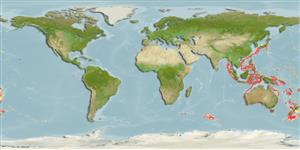Actinopterygii (ray-finned fishes) >
Gadiformes (Cods) >
Macrouridae (Grenadiers or rattails) > Macrourinae
Etymology: Ventrifossa: Latin, venter, ventris = belly + Latin, fosa = pit (Ref. 45335). More on author: Iwamoto.
Environment / Climate / Range
Ecology
Marine; bathydemersal; depth range 420 - 886 m (Ref. 35909). Deep-water, preferred ?
Western Pacific: South China Sea and northern Australia (including Western Australia).
Size / Weight / Age
Maturity: Lm ? range ? - ? cm
Max length : 34.0 cm TL male/unsexed; (Ref. 35909)
Short description
Morphology | Morphometrics
Dorsal
spines
(total): 2;
Anal
spines: 0. Pelvic fin rays 9-10; second spinous ray of first dorsal fin with smooth leading edge; a well marked median nasal streak; chin barbel dark, length 17-24% of head length; outer premaxillary teeth notably larger than teeth of inner band; dorsum not strongly demarcated in color from rest of body in preserved specimens; suborbital shelf narrows anteriorly, somewhat constricted at anterior end.
A benthic species found on the continental slope (Ref. 75154).
Life cycle and mating behavior
Maturity | Reproduction | Spawning | Eggs | Fecundity | Larvae
Iwamoto, T. and A. Williams, 1999. Grenadiers (Pisces, Gadiformes) from the continental slope of western and northwestern Australia. Proc. Calif. Acad. Sci. 51(3):105-243. (Ref. 35909)
IUCN Red List Status (Ref. 115185)
CITES (Ref. 94142)
Not Evaluated
Threat to humans
Harmless
Human uses
More information
Common namesSynonymsMetabolismPredatorsEcotoxicologyReproductionMaturitySpawningFecundityEggsEgg development
Age/SizeGrowthLength-weightLength-lengthLength-frequenciesMorphometricsMorphologyLarvaeLarval dynamicsRecruitmentAbundance
ReferencesAquacultureAquaculture profileStrainsGeneticsAllele frequenciesHeritabilityDiseasesProcessingMass conversion
Tools
Special reports
Download XML
Internet sources
